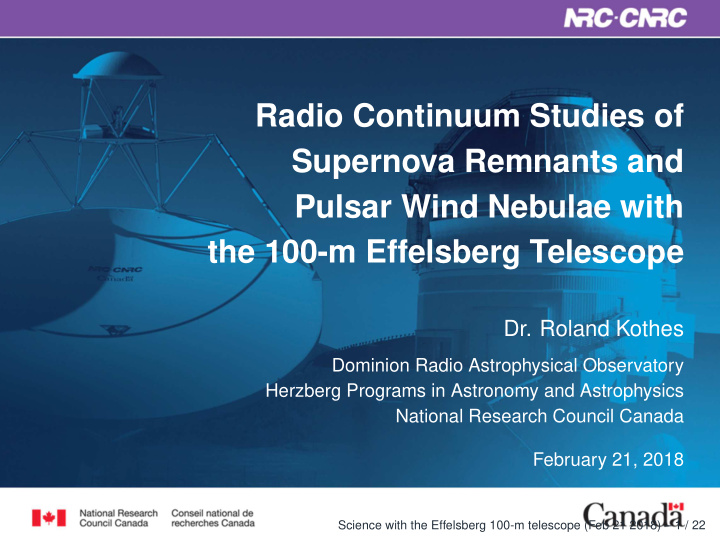



Radio Continuum Studies of Supernova Remnants and Pulsar Wind Nebulae with the 100-m Effelsberg Telescope Dr. Roland Kothes Dominion Radio Astrophysical Observatory Herzberg Programs in Astronomy and Astrophysics National Research Council Canada February 21, 2018 Science with the Effelsberg 100-m telescope (Feb 21 2018) – 1 / 22
Why do we care? Supernovae are the most significant source of: � chemical enrichment � energy � cosmic ray acceleration � in the interstellar medium. Science with the Effelsberg 100-m telescope (Feb 21 2018) – 2 / 22
Why do we care? Supernovae are the most significant source of: � chemical enrichment � energy � cosmic ray acceleration � in the interstellar medium. They compress and amplify magnetic fields and play an � important role in the evolution of our Galaxy. Science with the Effelsberg 100-m telescope (Feb 21 2018) – 2 / 22
Why do we care? Supernovae are the most significant source of: � chemical enrichment � energy � cosmic ray acceleration � in the interstellar medium. They compress and amplify magnetic fields and play an � important role in the evolution of our Galaxy. Can put constraints on pulsar characteristics, such as age, � velocity, spin axis, progenitor star, and many more. Science with the Effelsberg 100-m telescope (Feb 21 2018) – 2 / 22
Evolution of SNRs and PWNe Science with the Effelsberg 100-m telescope (Feb 21 2018) – 3 / 22
Radio Studies of SNRs and PWNe Ideal telescope combinations for the study of medium sized SNRs and PWNe: Northern Hemisphere: � Low frequency: DRAO-ST or VLA + Effelsberg � High Frequency: Effelsberg � Southern Hemisphere: � Low frequency: ATCA or VLA + Parkes � High Frequency: Parkes? � Science with the Effelsberg 100-m telescope (Feb 21 2018) – 4 / 22
SNR G106.3+2.7 in the NVSS Pulsar J2229+6114 Science with the Effelsberg 100-m telescope (Feb 21 2018) – 5 / 22
SNR G106.3+2.7 in the CGPS Pulsar J2229+6114 Science with the Effelsberg 100-m telescope (Feb 21 2018) – 5 / 22
Discovery of new SNRs: G182.4+4.3 Effelsberg 11cm Survey: F¨ urst E., Reich W., Reich P ., Reif K., 1990, A&AS 85 691 Science with the Effelsberg 100-m telescope (Feb 21 2018) – 6 / 22
Discovery of new SNRs: G182.4+4.3 Effelsberg 6cm Observation Kothes R., F¨ urst E., Reich W., 1998, A&A 331, 661 Science with the Effelsberg 100-m telescope (Feb 21 2018) – 6 / 22
Discovery of new SNRs: G181.1+9.5 Kothes R., Reich P ., Foster T.J., Reich W., 2017, A&A 597, A116 At rms of 100 µ K or � 40 µ Jy/beam, the most sen- sitive 6cm map every ob- served with a single dish telescope. Only SNR known to interact � with high velocity clouds. Science with the Effelsberg 100-m telescope (Feb 21 2018) – 7 / 22
Magnetic Environment of SNRs Kothes, R. & Brown, J.-A., 2009, IAU Symposium 259, 75 B 0 SNR SNR Science with the Effelsberg 100-m telescope (Feb 21 2018) – 8 / 22
G182.4+4.3 Science with the Effelsberg 100-m telescope (Feb 21 2018) – 9 / 22
G182.4+4.3 in the Milky Way Galaxy G182.4+4.3 Science with the Effelsberg 100-m telescope (Feb 21 2018) – 10 / 22
DA 530 (G93.3+6.9) rad/m 2 0 -50 -100 Science with the Effelsberg 100-m telescope (Feb 21 2018) – 11 / 22
DA 530 Science with the Effelsberg 100-m telescope (Feb 21 2018) – 12 / 22
G67.7+1.8 -80 south north -90 -100 Rotation Measure [rad/m 2 ] -110 -120 -130 -140 -150 -160 -170 -0.2 -0.1 0 0.1 0.2 Offset [Radius] ⇒ Stellar Wind Bubble Science with the Effelsberg 100-m telescope (Feb 21 2018) – 13 / 22
Radio Emission from SNR G57.2+0.8 Kothes R. Sun X., Gaensler B., Reich W., 2018, ApJ 852, 54: Science with the Effelsberg 100-m telescope (Feb 21 2018) – 14 / 22
The spectrum of the ”Boomerang” Science with the Effelsberg 100-m telescope (Feb 21 2018) – 15 / 22
The Boomerang PWN Kothes R., Landecker T.L., Reich W., Safi-Harb S., Arzoumanian Z., 2008, ApJ 687, 516: Science with the Effelsberg 100-m telescope (Feb 21 2018) – 16 / 22
PWN DA 495 Kothes R., Reich W., Uyanıker B., 2006, ApJ 638, 225: Science with the Effelsberg 100-m telescope (Feb 21 2018) – 17 / 22
PWN DA 495 Radio Continuum Science with the Effelsberg 100-m telescope (Feb 21 2018) – 18 / 22
Radio Observations of PWN CTB87 Kothes R., Reich W., Safi-Harb S., Matheson H., F¨ urst E., 2018: Science with the Effelsberg 100-m telescope (Feb 21 2018) – 19 / 22
Radio Observations of PWN CTB87 Science with the Effelsberg 100-m telescope (Feb 21 2018) – 20 / 22
Radio Observations of PWN CTB87 Science with the Effelsberg 100-m telescope (Feb 21 2018) – 21 / 22
Summary Radio Continuum and Linear Polarization Measurements with the � Effelsberg telescope are essential for the study of Galactic SNRs and PWNe. We can study the acceleration of the Cosmic Ray population in � the Galaxy. We can use SNRs to probe magnetic environments and draw � conclusions for the large-scale magnetic field in the Galaxy. We can estimate important pulsar properties and sometimes � characteristics of the supernova’s progenitor. Science with the Effelsberg 100-m telescope (Feb 21 2018) – 22 / 22
Recommend
More recommend